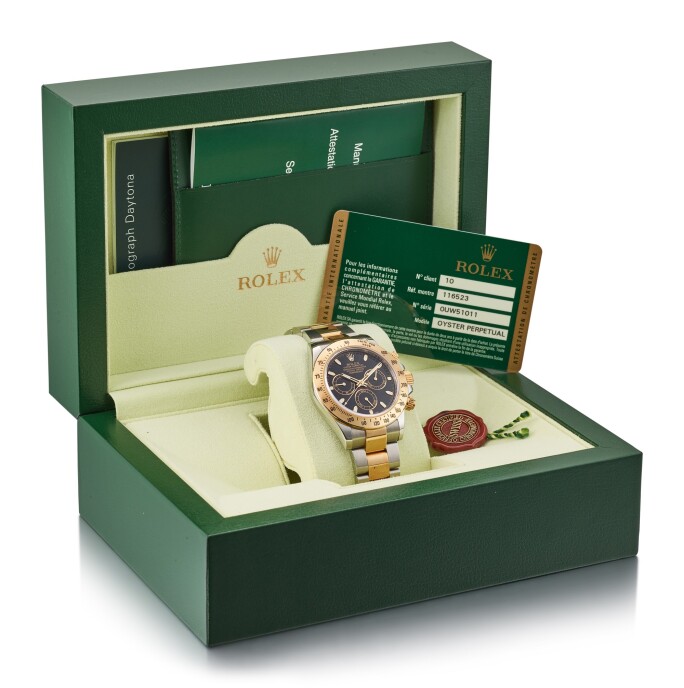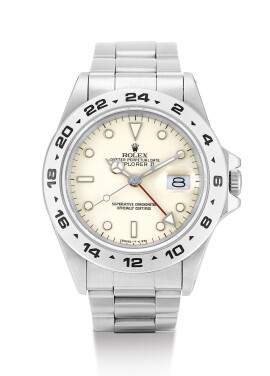S ometimes it just starts with one thing that sparks a collector’s interest. It might be diving watches or military watches. Some are fascinated by highly complicated watches, minute repeaters, or vintage watches. There are just so many ways watch enthusiasts have discovered this passion. Many have started their collections with Rolex, and for good reason. Ahead of Sotheby’s Watches Weekly Online Auction, specialist John Chan discusses the singular aesthetics and features of Rolex watches, and the fascinating history behind the designs.
What is it about Rolex watches that appeal to the collector?
Rolex has always been striving to make history. They were competing to be the first watch on the moon, and although, as you know, that title ultimately went to Omega, they were very close and put up a real challenge. Rolex made the first watch to go on Mount Everest – the Oyster Perpetual. And they worked with Pan Am to design the GMT Master, the first watch that could show two time-zones for pilots. The Submariner was the first watch to go 200 metres below water. The stories behind Rolex watches are very much a part of history. For Rolex, and vintage watches, in general, this appeal is all about technological breakthrough.
What are some examples of these technological breakthroughs and innovative features?
It is the continuous search, the striving for better materials. It all lies in the small details. Take, for example, the luminescence used on watches. On one of its earliest models with this feature, Rolex used something called ‘Radium,’ which people later discovered is radioactive. They stopped using it then switched to the material called tritium, then to luminova and then to superluminova, which is what we are using today. Superluminova is the same material that can also be found on fire exit emergency signs, doorways and staircases. These aren’t rare materials and can be seen in everyday life, however, the example illustrates that continuous drive to improve the design. The dial is another example that has gone through many transitions. It has evolved from glossy dial to porcelain dial, to the style that we are using today. Watchmakers are still looking for the material that will create a dial that will last forever.
What is a good starting point when looking at vintage Rolex watches?
There are so many possibilities. As I mentioned, Submariner was a big breakthrough technologically, but it also has a lot of cultural significance. It was featured in the James Bond movie, and has been worn by a lot of celebrities. So I would definitely recommend looking at Submariners. These Rolex watches either have ‘big crowns’ or ‘small crowns.’ The former style was used by military personnel, who were required to wear gloves at all times, so the larger crown was better suited to allow them to set the time.
The Submariner went through different stages. The earlier ones in the 1950s didn’t have a crown guard. Thus, the watch looks sleeker compared to the ones today. The purpose of the crown guard is to secure the crown. If I were wearing this watch and, say, I accidentally hit the watch against the desk, the crown would probably fall off, so the crown guard is there to protect it. Rolex also designed features that were very specific to different purposes. Watches designed for the military have the lugs with the spring bar attached together, so the watch won’t end up flying off the wrist of the soldier during combat. These details are all specific to the context and time when these watches were made.
Is it true that Rolex even played a part in world diplomacy?
Yes, in fact, starting at the beginning of the 1970’s, the United Arab Emirates and Arab Nations commissioned watches from Rolex to give as gifts to officials, diplomats and dignitaries. The Ultimate Daytona by Pucci Papaleo represents a very rare example of this golden era and features a dial known as The Desert Eagle. Featuring a highly unusual personalised dial, a UAE coat of arms has been rendered by hand in polychrome enamel illustrating the Quraysh Hawk and replaces the traditional Rolex Cosmograph signatures found on regular production models. In a standing position, the hawk’s feet rest on top of the ruler of Dubai’s signature. Mohammed bin Rashid Al Makhtoum. Above 6 o’clock the Emir’s name is also signed which differs from the other known examples that feature the mark of the Wazarah Ad Difa’a department in the same position. In addition, the ‘Sigma’ designation at the bottom of the dial is correct for this model.








